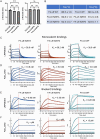Effects of Fc glycosylation on the activity of WNT mimetic agonistic antibodies
- PMID: 38371954
- PMCID: PMC10873268
- DOI: 10.1093/abt/tbae002
Effects of Fc glycosylation on the activity of WNT mimetic agonistic antibodies
Abstract
Monoclonal antibodies have been explored in a broad range of applications including receptor agonism. Given the importance of receptor conformation in signaling, the agonistic activity of antibodies that engage these receptors are influenced by many parameters. Tetravalent bispecific antibodies that target the frizzled and lipoprotein receptor-related protein receptors and subsequently activate WNT ("Wingless-related integration site" or "Wingless and Int-1" or "Wingless-Int") signaling have been constructed. Because WNT activation stimulates stem cell proliferation and tissue regeneration, immune effector functions should be eliminated from therapeutic antibodies targeting this pathway. Here, we report an unexpected effect of Fc glycosylation on the agonistic activity of WNT mimetic antibodies. Our findings underscore the importance of antibody format, geometry and epitope in agonistic antibody design, and highlight the need to establish appropriate early discovery screening strategies to identify hits for further optimization.
Keywords: FZD; LRP; WNT; WNT mimetic; agonist; bispecific antibody; glycosylation; surrogate.
© The Author(s) 2024. Published by Oxford University Press on behalf of Antibody Therapeutics.
Conflict of interest statement
All authors are current or former full-time employees and shareholders of Surrozen, Inc. YL is Executive Vice President of Research at Surrozen, Inc. Patent applications are pending for the work described herein.
Figures



Similar articles
-
Robust Colonic Epithelial Regeneration and Amelioration of Colitis via FZD-Specific Activation of Wnt Signaling.Cell Mol Gastroenterol Hepatol. 2022;14(2):435-464. doi: 10.1016/j.jcmgh.2022.05.003. Epub 2022 May 13. Cell Mol Gastroenterol Hepatol. 2022. PMID: 35569814 Free PMC article.
-
A biparatopic agonistic antibody that mimics fibroblast growth factor 21 ligand activity.J Biol Chem. 2018 Apr 20;293(16):5909-5919. doi: 10.1074/jbc.RA118.001752. Epub 2018 Feb 26. J Biol Chem. 2018. PMID: 29483191 Free PMC article.
-
Development of Potent, Selective Surrogate WNT Molecules and Their Application in Defining Frizzled Requirements.Cell Chem Biol. 2020 May 21;27(5):598-609.e4. doi: 10.1016/j.chembiol.2020.02.009. Epub 2020 Mar 26. Cell Chem Biol. 2020. PMID: 32220333
-
Design principles and therapeutic applications of novel synthetic WNT signaling agonists.iScience. 2024 May 8;27(6):109938. doi: 10.1016/j.isci.2024.109938. eCollection 2024 Jun 21. iScience. 2024. PMID: 38832011 Free PMC article. Review.
-
LRPs in WNT Signalling.Handb Exp Pharmacol. 2021;269:45-73. doi: 10.1007/164_2021_526. Handb Exp Pharmacol. 2021. PMID: 34490514 Review.
References
-
- Mullard, A. FDA approves 100th monoclonal antibody product. Nat Rev Drug Discov 2021; 20: 491–5. - PubMed
LinkOut - more resources
Full Text Sources
Miscellaneous
